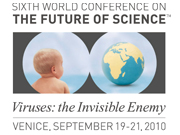Sixth World Conference on The Future of Science - Viruses: the Invisible Enemy
 The Sixth World Conference on The Future of Science has explored another theme of major public interest, and subject of intense scientific enquiry: Viruses, those mysterious and invisible agents responsible for so many human diseases. Speakers of international stature have explained how viruses evolved, how man has coped with viruses in the past, how they enter and take over cells, and how they evade host defenses.
The Sixth World Conference on The Future of Science has explored another theme of major public interest, and subject of intense scientific enquiry: Viruses, those mysterious and invisible agents responsible for so many human diseases. Speakers of international stature have explained how viruses evolved, how man has coped with viruses in the past, how they enter and take over cells, and how they evade host defenses.
They have discussed where new viruses come from, and whether it will be possible for a new virus to destroy the human race.
The role of viruses in cancer, the prevention and treatment of pandemic flu and AIDS, and their potential role as therapeutic agents has also been examined. Viruses are small and relatively simple forms of life that have developed very complex strategies to survive and disseminate. They are obligatory parasites, since they can only multiply within living cells. Nevertheless, they number among the world's biggest killers, now as in the past.
The outbreaks of highly lethal viral diseases such as Ebola and Hantavirus have caused great public concern. Viruses also cause many important plant diseases and are responsible for huge losses in crop production in all parts of the world. But viruses can also be allies: they are tools for gene therapy and can be made to work as tumor-killing agents.
The ultimate aim of the Conference has been to indicate how science and technology can meet global viral threats by developing new vaccines and new antiviral drugs, and by addressing the economic, political and ethical issues related to the prevention and treatment of viral diseases.





